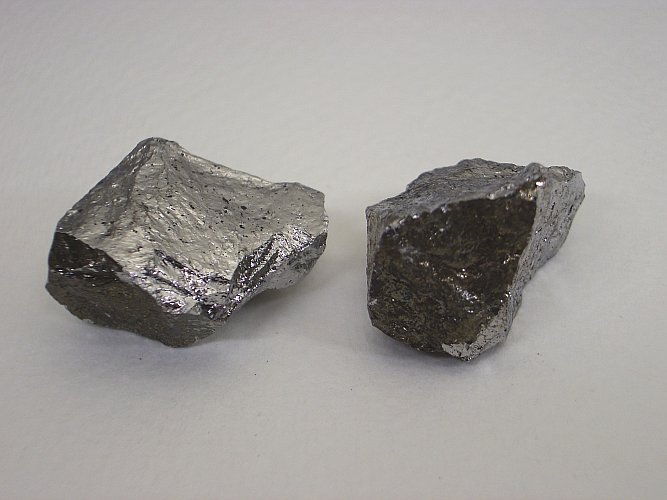


Manganese
 Manganese is a gray/white metal, which is oxidized easily.
It is slowly attacked by water. By dilute acids, it is attacked more quickly.
Manganese is a gray/white metal, which is oxidized easily.
It is slowly attacked by water. By dilute acids, it is attacked more quickly.
The metal can be purchased from several vendors on eBay in all kinds of quantities. For the home chemist, however, it is more convenient to have a water-soluble compound of this metal at hand.
![]()
The most stable oxidation states of manganese in its compounds are +2, +4 and +7. It, however, also is possible quite well to prepare aqueous solutions, containing manganese in its +3 and +6 oxidation states. The +5 oxidation state can only be obtained in aqueous solutions in a transient state.
For the general public a few manganese compounds are accessible:
- manganese (II) sulfate, MnSO4ĚH2O
- manganese (II) carbonate, MnCO3
- manganese (VI) oxide, MnO2
- potassium permanganate, KMnO4
![]() Manganese (II) sulfate is a light pink powder, which dissolves in water easily.
Solutions of manganese (II) are almost colorless. The pink color hardly is
visible in solution. Manganese (II) ions only have limited coordination
chemistry. However, there is an interesting redox chemistry. Manganese (II)
sulfate is an interesting compound for the home lab. It can be ordered from
chemical supply houses. When one also has access to potassium permanganate, then
there is less need for manganese (II) sulfate. Solutions of manganese (II) salts
can easily be prepared from potassium permanganate.
Manganese (II) sulfate is a light pink powder, which dissolves in water easily.
Solutions of manganese (II) are almost colorless. The pink color hardly is
visible in solution. Manganese (II) ions only have limited coordination
chemistry. However, there is an interesting redox chemistry. Manganese (II)
sulfate is an interesting compound for the home lab. It can be ordered from
chemical supply houses. When one also has access to potassium permanganate, then
there is less need for manganese (II) sulfate. Solutions of manganese (II) salts
can easily be prepared from potassium permanganate.
![]() Manganese (II) carbonate is available at pottery and ceramics shops. The pure
compound is pale pink, the commercial product usually is light brown, due to
some manganese (IV) impurities. Manganese (II) carbonate easily dissolves in
dilute acids, forming colorless solutions. The commercial product also can be
dissolved cleanly, by adding a minute quantity of a sulfite, which reduces the
brown manganese (IV) compounds.
Manganese (II) carbonate is available at pottery and ceramics shops. The pure
compound is pale pink, the commercial product usually is light brown, due to
some manganese (IV) impurities. Manganese (II) carbonate easily dissolves in
dilute acids, forming colorless solutions. The commercial product also can be
dissolved cleanly, by adding a minute quantity of a sulfite, which reduces the
brown manganese (IV) compounds.
![]() Manganese (IV) oxide is available as a dark brown or black crystalline powder at
pottery and ceramics shops. The product, which can be obtained there, usually
contains some silicate impurity. Manganese (IV) oxide slowly dissolves in dilute
acid, to which some sulfite is added, forming a manganese (II) solution. The
silicate impurity remains as a white solid, which can easily be separated from
the clear liquid. Manganese (IV) oxide in the solid state also can be
interesting in some pyrotechnic experiments.
Manganese (IV) oxide is available as a dark brown or black crystalline powder at
pottery and ceramics shops. The product, which can be obtained there, usually
contains some silicate impurity. Manganese (IV) oxide slowly dissolves in dilute
acid, to which some sulfite is added, forming a manganese (II) solution. The
silicate impurity remains as a white solid, which can easily be separated from
the clear liquid. Manganese (IV) oxide in the solid state also can be
interesting in some pyrotechnic experiments.
![]() Potassium permanganate is the most interesting manganese compound, which is
available for the public. It is available at photography raw chemical suppliers,
in shops for textile processing chemicals and also in some shops, which sell
equipment and chemicals for aquarium/water conditioning. Potassium permanganate
is a strong and powerful oxidizer, which is dark purple in the solid state and
which dissolves moderately well, forming extremely dark solutions. Potassium
permanganate can be used as a source for manganese in other oxidation states
(+2, +4 and +6 and to a lesser extent also +3) in aqueous solutions. It also can
be used in dry-chemical and pyrotechnic experiments.
Potassium permanganate is the most interesting manganese compound, which is
available for the public. It is available at photography raw chemical suppliers,
in shops for textile processing chemicals and also in some shops, which sell
equipment and chemicals for aquarium/water conditioning. Potassium permanganate
is a strong and powerful oxidizer, which is dark purple in the solid state and
which dissolves moderately well, forming extremely dark solutions. Potassium
permanganate can be used as a source for manganese in other oxidation states
(+2, +4 and +6 and to a lesser extent also +3) in aqueous solutions. It also can
be used in dry-chemical and pyrotechnic experiments.
![]() In dry
chemical experiments, reactions of potassium permanganate can be very violent
and very hot, so care must be taken when these experiments are performed.
In dry
chemical experiments, reactions of potassium permanganate can be very violent
and very hot, so care must be taken when these experiments are performed.